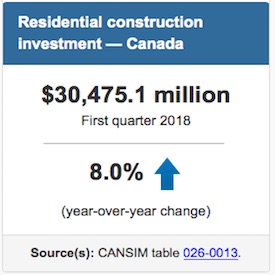Q1 2018 Investment in Residential Construction Up 8% YOY

June 11, 2018
Investment in residential construction increased by 8.0% to $30.5 billion in the first quarter of 2018 compared with the same quarter in 2017.
All components, with the exception of mobile homes, contributed to the quarterly year-over-year increase in spending on residential construction. The growth was led by spending on apartment buildings, which accounted for 39.5% of the total increase (+$890.8 million or +21.5%), followed by investment in renovations (+$677.9 million or +5.5%).
British Columbia posted the biggest gains in spending on residential construction (+$859.8 million or +16.2%), followed by Quebec (+$691.4 million or +14.9%). Apartment building construction spending contributed significantly to the growth in both Quebec (+$492.6 million) and British Columbia (+$199.0 million). Additionally, investment in acquisition costs drove the growth in British Columbia (+$253.2 million).
Saskatchewan was the only province to post a quarterly year-over-year decline (-$19.6 million or -2.7%), mainly due to reduced spending on single home construction, down $34.3 million compared with the previous year.
Apartment building construction investment posted gains in nine provinces, led by Quebec, where spending was up 55.8% (+$492.6 million). For the province, this marked the largest year-over-year increase since the current series began in 1996. Alberta was the only province to report a drop in spending on apartment building construction, down $4.7 million compared with the first quarter of 2017.
Spending on renovations increased for all provinces (+$677.9 million or + 5.5%), led by Ontario (+$239.6 million) and Quebec (+$169.2 million). Among the Atlantic provinces, Nova Scotia (+$11.3 million) and New Brunswick (+$10.2 million) posted the largest gainsfor this component. In Western Canada, investment on renovations was led by British Columbia (+$123.8 million), Alberta (+$55.3 million) and Manitoba (+$37.7 million).
Investment on single homes posted its lowest year-over-year rise (+$40.3 million or +0.6%) since the fourth quarter of 2015. The increase in this component was led by British Columbia (+$173.6 million) and Alberta (+$142.2 million).
Source: Statistics Canada, www150.statcan.gc.ca/n1/daily-quotidien/180601/dq180601c-eng.htm




![Guide to the Canadian Electrical Code, Part 1[i] – A Road Map: Section 52 — Diagnostic imaging installations](https://electricalindustry.ca/wp-content/uploads/2022/11/Guide-CE-Code-2-768x432.png)





![Guide to the Canadian Electrical Code, Part 1[i] – A Road Map: Section 52 — Diagnostic imaging installations](https://electricalindustry.ca/wp-content/uploads/2022/11/Guide-CE-Code-2.png)






